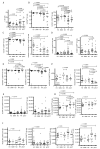Alterations of NK Cell Phenotype in the Disease Course of Multiple Myeloma
- PMID: 33435153
- PMCID: PMC7827733
- DOI: 10.3390/cancers13020226
Alterations of NK Cell Phenotype in the Disease Course of Multiple Myeloma
Abstract
Accumulating evidence demonstrates important roles for natural killer (NK) cells in controlling multiple myeloma (MM). A prospective flow cytometry-based analysis of NK cells in the blood and bone marrow (BM) of MM patient subgroups was performed (smoldering (SMM), newly diagnosed (ND), relapsed/refractory, (RR) and post-stem cell transplantation (pSCT)). Assessments included the biomarker expression and function of NK cells, correlations between the expression of receptors on NK cells with their ligands on myeloma cells, and comparisons between MM patient subgroups and healthy controls. The most striking differences from healthy controls were found in RR and pSCT patients, in which NK cells were less mature and expressed reduced levels of the activating receptors DNAM-1, NKG2D, and CD16. These differences were more pronounced in the BM than in blood, including upregulation of the therapeutic targets TIM3, TIGIT, ICOS, and GITR. Their expression suggests NK cells became exhausted upon chronic encounters with the tumor. A high expression of SLAMF7 on blood NK cells correlated with shorter progression-free survival. This correlation was particularly evident in ND patients, including on mature CD56dim NK cells in the BM. Thus, our NK cell analysis identified possible therapeutic targets in MM and a biomarker with prognostic potential for disease progression.
Keywords: DNAM-1; GITR; NCR; NK cells; NKG2D; SLAMF7; blood; bone marrow; multiple myeloma.
Conflict of interest statement
This work was supported by grants from Bristol-Myers Squibb (BMS), which markets elotuzumab. The funders assisted in the original design of the study and provided editorial suggestions in the final stage of writing the manuscript, but had no role in the collection, analysis, or interpretation of the data or in the decision to publish the results. N.A.B. and M.D.R. were employees of BMS. K.S.C. and A.D.C. have received research funding from and have served on scientific advisory boards for BMS. K.S.C. has also received research funding from Janssen, Genentech, Horizon Pharma, NantKwest, and Immune Oncology Biosciences. T.P. is currently an employee of Janssen.
Figures





References
Grants and funding
LinkOut - more resources
Full Text Sources
Other Literature Sources
Medical
Research Materials
Miscellaneous

